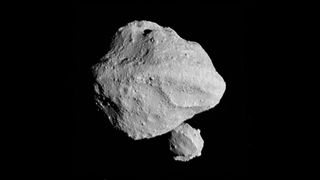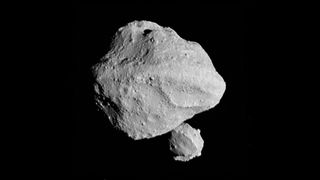The unusual shapes of the tiny asteroids Dimorphos and Selam have perplexed astronomers for years, but a new study finally explains how they got so strange. It also suggests these bizarrely shaped “moonlets” may be more common than scientists thought.
Binary asteroids — pairs of asteroids that are essentially mini versions of the Earth-moon system — are pretty common in our cosmic neighborhood. These include the Didymos-Dimorphos duo that headlined NASA’s 2022 Double Asteroid Redirection Test (DART) mission. Previous research suggests that such binary asteroids form when a rubble-pile “parent” asteroid — composed of loosely held rocks — spins so fast that it sheds some of its mass, which coalesces into the second, smaller satellite or “moonlet” asteroid.
Most moonlet asteroids look like upright, blunt-ended footballs as they orbit their typically top-shaped parents; such moonlets are described as being “prolate.” But some have odder shapes. Take Dimorphos — that is, before DART impacted it. It was an “oblate spheroid” — a sphere squished at its poles and stretched along its midriff, like a watermelon. And tiny Selam, the recently discovered satellite of the asteroid Dinkinesh (aka “Dinky”), is even more peculiar, consisting of two connected rocky spheres.
The moonlets’ weird shapes have puzzled astronomers, including John Wimarsson, a graduate student at the University of Bern in Switzerland and the new study’s lead author. “We have never seen such asteroid satellites before and they cannot be directly explained by traditional binary asteroid formation models,” he told Live Science by email.
To understand the asteroids’ odd shapes, Wimarsson and his colleagues — from European and American universities — developed two sets of detailed computer models. The first set simulated how the parent asteroids’ shapes would change as they spun rapidly and flung out debris. The second set assumed the debris formed a doughnut-shaped zone — called the debris disk — around the parent asteroid. The algorithms then tracked the movement of all the fragments as they experienced gravitational tugs from each other and their parent and collided to form aggregates. The researchers also considered two kinds of parent asteroids, resembling “rubber-ducky” Ryugu and Didymos in size and density.
The results, published online July 20 in the journal Icarus, revealed that there are two primary factors that govern a moonlet asteroid’s final shape: the gravitational force the parent exerts, and the nature of collisions the moonlet endures with other rocky objects in the debris disk.
However, other parameters determine which of these factors plays a bigger role. One parameter is the parent asteroid’s density. Denser asteroids, like Didymos, spin faster than lighter, Ryugu-like ones, creating wider debris disks, which, in turn, cause moonlets to form farther away from the parent.

The researchers found that satellites that form a certain distance from the parent usually acquire prolate shapes. At this distance, called the Roche limit, the parent’s gravity balances out the moonlet asteroid’s internal force, maintaining the moonlet’s shape as it slowly grows by colliding and fusing with other debris.
On the other hand, moonlet asteroids that form beyond the Roche limit acquire oblate shapes because they are beyond the gravitational grip of the parent asteroid. As they collide with other, co-orbiting rock debris, they grow more uniformly than their prolate counterparts. Nonetheless, most oblate asteroids form way below the Roche limit; being too close causes moonlets to get ripped apart by the parent asteroid’s gravity, making them lose their prolate shapes. Such moonlets are more likely to be shaped into oblate spheroids after colliding with other precursor moonlets.
RELATED STORIES
The angle at which two precursor moonlets collide is also important in determining the final shape. According to Wimarsson, if the two asteroids collide side to side so that they align along their short axes, the resulting shape is more oblate. “If we on the other hand were to merge them edge-to-edge such that their longest axes are aligned, this creates a bilobate [two-lobed] object,” similar to the moonlet Selam, he added.
The team’s findings extend beyond providing recipes for the shapes of Dimorphos and Selam. Considering that nearly half of their simulations generated abnormally shaped asteroids, the researchers believe such oddities may be more common than previously estimated. But because the tech used to study asteroids today is biased against spotting oblate asteroids, they’re often missed.



